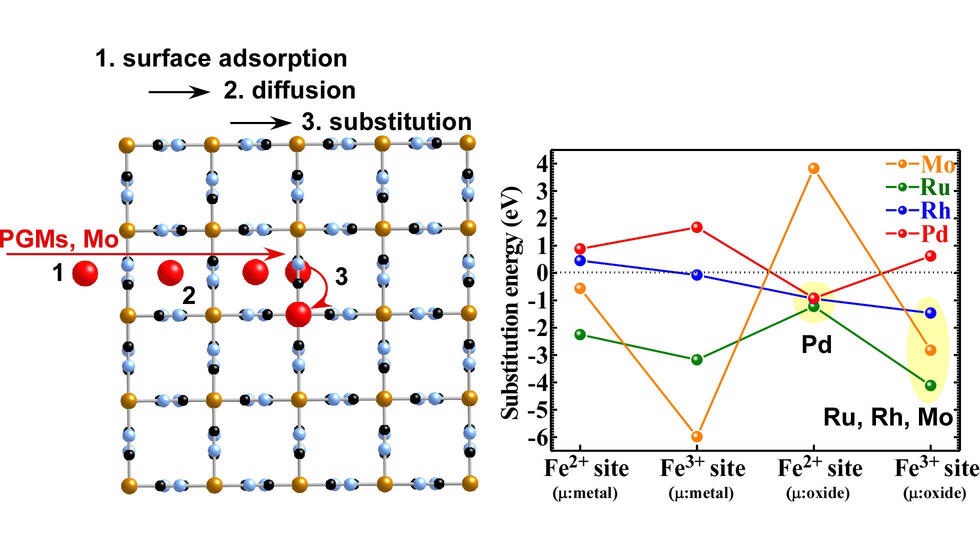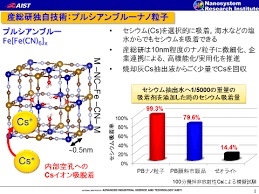

Nagoya University: Highly efficient recovery of platinum groups:
-Recovered with the blue pigment “Prussian blue” (PB)-
Discovered by Professors of Nagoya University:
Nagoya University Graduate School
Professor Jun Onoe = Nanomaterial Science =
Tokyo Institute of Technology
Kenji Takeshita Specially Appointed Professor = Nuclear Chemical Engineering =
The blue pigment “Prussian blue” (PB),
Rare metals such as palladium,
The research group discovered a phenomenon of efficient recovery.
Radioactive waste:
Vitrification process:
When vitrifying high-level radioactive waste
Rare metals cause a decrease in the operating rate of melting.
It may lead to the solution of this problem.
Research group:
Rare metals such as ruthenium, rhodium, palladium, etc.
In a solution containing platinum group elements,
PB nanoparticles (15 nm in diameter) were placed.
After the rare metals were taken into the nanospace, we discovered “a phenomenon that replaces iron ions”.
Replacement rate in 24 hours:
Ruthenium 39.0%,
Rhodium 47.8%,
It was highly efficient with 87.0% palladium.
Uranium fission:
For nuclear reactors:
Uranium with a mass number of 235 repeats fission to produce rare metals.
In the case of melting furnace:
When high-level radioactive waste is vitrified in a melting furnace,
Rare metals stick to the walls of the furnace, degrading the quality of the vitrified material.
Therefore, it is necessary to “clean the furnace frequently”.
As a result, it also leads to an increase in vitrified bodies.
Professor Onoe:
If the “radioactivity of recovered rare metals” decreases, it will become a valuable resource.
Useful for “recycling rare metals such as discarded electronic parts”.
reaserch result:
It was published in the electronic version (March 24) of the international scientific journal “Scientific Reports”.
Mainichi Shimbun
https://mainichi.jp/articles/20220527/k00/00m/040/093000c
Université de Nagoya : Récupération hautement efficace des groupes de platine :
-Recouvert avec le pigment bleu “bleu de Prusse” (PB)-
Découvert par des professeurs de l’Université de Nagoya :
École supérieure de l’Université de Nagoya
Professeur Jun Onoe = Science des nanomatériaux =
Institut de technologie de Tokyo
Kenji Takeshita Professeur spécialement nommé = Génie chimique nucléaire =
Le pigment bleu « bleu de Prusse » (PB),
Les métaux rares comme le palladium,
Le groupe de recherche a découvert un phénomène de récupération efficace.
Déchet radioactif:
Processus de vitrification :
Lors de la vitrification de déchets hautement radioactifs
Les métaux rares provoquent une diminution du taux de fonctionnement de la fusion.
Cela peut conduire à la solution de ce problème.
Groupe de recherche:
Les métaux rares tels que le ruthénium, le rhodium, le palladium, etc.
Dans une solution contenant des éléments du groupe du platine,
Des nanoparticules de PB (15 nm de diamètre) ont été placées.
Après l’introduction des métaux rares dans le nanoespace, nous avons découvert “un phénomène qui remplace les ions de fer”.
Taux de remplacement en 24h :
Ruthénium 39,0%,
Rhodium 47,8%,
Il était très efficace avec 87,0 % de palladium.
Fission de l’uranium :
Pour les réacteurs nucléaires :
L’uranium avec un nombre de masse de 235 répète la fission pour produire des métaux rares.
Dans le cas d’un four de fusion :
Lorsque des déchets hautement radioactifs sont vitrifiés dans un four de fusion,
Les métaux rares collent aux parois du four, dégradant la qualité de la matière vitrifiée.
Par conséquent, il est nécessaire de “nettoyer fréquemment le four”.
Par conséquent, cela entraîne également une augmentation des corps vitrifiés.
Professeur Onoe :
Si la “radioactivité des métaux rares récupérés” diminue, elle deviendra une ressource précieuse.
Utile pour “recycler les métaux rares tels que les pièces électroniques mises au rebut”.
résultat de la recherche :
Il a été publié dans la version électronique (24 mars) de la revue scientifique internationale “Scientific Reports”.
Mainichi Shimbun
Universität Nagoya: Hocheffiziente Rückgewinnung von Platingruppen:
-Wiedergewonnen mit dem Blaupigment “Preußischblau” (PB)-
Von Professoren der Universität Nagoya entdeckt:
Graduiertenschule der Universität Nagoya
Professor Jun Onoe = Nanomaterialwissenschaft =
Technisches Institut Tokio
Kenji Takeshita Speziell ernannter Professor = Nuclear Chemical Engineering =
Das blaue Pigment „Preußischblau“ (PB),
Seltene Metalle wie Palladium,
Die Forschungsgruppe entdeckte ein Phänomen der effizienten Erholung.
Radioaktiver Müll:
Verglasungsprozess:
Beim Verglasen von hochradioaktiven Abfällen
Seltene Metalle verursachen eine Verringerung der Betriebsgeschwindigkeit des Schmelzens.
Es kann zur Lösung dieses Problems führen.
Forschungsgruppe:
Seltene Metalle wie Ruthenium, Rhodium, Palladium usw.
In einer Lösung, die Elemente der Platingruppe enthält,
PB-Nanopartikel (15 nm Durchmesser) wurden platziert.
Nachdem die seltenen Metalle in den Nanoraum gebracht wurden, entdeckten wir „ein Phänomen, das Eisenionen ersetzt“.
Ersatzrate in 24 Stunden:
Ruthenium 39,0 %,
Rhodium 47,8 %,
Es war mit 87,0 % Palladium hocheffizient.
Uranspaltung:
Für Kernreaktoren:
Uran mit einer Massenzahl von 235 wiederholt die Spaltung, um seltene Metalle zu produzieren.
Im Falle eines Schmelzofens:
Bei der Verglasung hochradioaktiver Abfälle in einem Schmelzofen
Seltene Metalle haften an den Wänden des Ofens und verschlechtern die Qualität des verglasten Materials.
Daher ist es notwendig, “den Ofen häufig zu reinigen”.
Dadurch kommt es auch zu einer Zunahme an verglasten Körpern.
Professor Onö:
Nimmt die „Radioaktivität zurückgewonnener seltener Metalle“ ab, wird daraus eine wertvolle Ressource.
Nützlich für das “Recycling seltener Metalle wie ausrangierter elektronischer Teile”.
Forschungsergebnis:
Es wurde in der elektronischen Version (24. März) der internationalen Wissenschaftszeitschrift „Scientific Reports“ veröffentlicht.
Mainichi Shimbun
The uptake characteristics of Prussian-blue nanoparticles for rare metal ions for recycling of precious metals from nuclear and electronic wastes
Scientific Reports
Abstract
We have examined
the uptake mechanisms of platinum-group-metals (PGMs) and molybdenum (Mo) ions into Prussian blue nanoparticles (PBNPs) in a nitric acid solution for 24-h sorption test,using inductively coupled plasma atomic emission spectroscopy, powder XRD, and UV–Vis-NIR spectroscopy in combination with first-principles calculations,
and revealed that the Ru4+and Pd2+ ions are incorporated into PBNPs by substitution with Fe3+ and Fe2+ ions of the PB framework, respectively,
whereas the Rh3+ ion is incorporated into PBNPs by substitution mainly with Fe3+ and minorly with Fe2+ion,
and Mo6+ ion is incorporated into PBNPs by substitution with both Fe2+and Fe3+ ions,
with maintaining the crystal structure before and after the sorption test.
Assuming that the amount of Fe elusion is equal to that of PGMs/Mo substitution, the substitution efficiency is estimated to be
39.0% for Ru,
47.8% for Rh,
87% for Pd,
17.1% for Mo6+.This implies that 0.13 g of Ru, 0.16 g of Rh, 0.30 g of Pd, and 0.107 g of Mo
can be recovered by using 1 g PBNPs with a chemical form of KFe(III)[Fe(II)(CN)6].